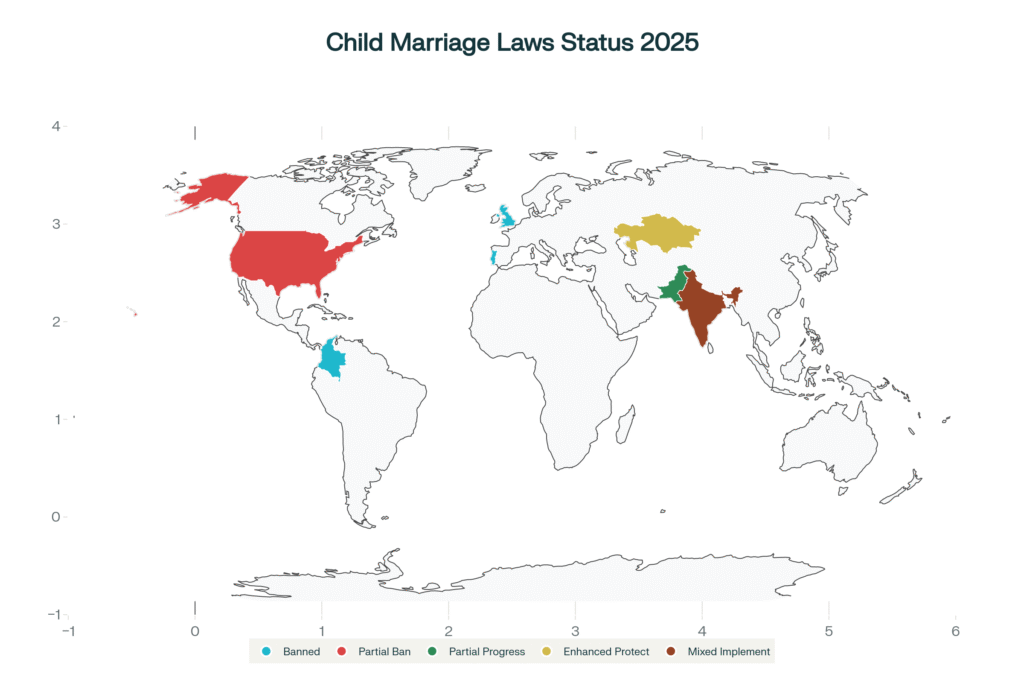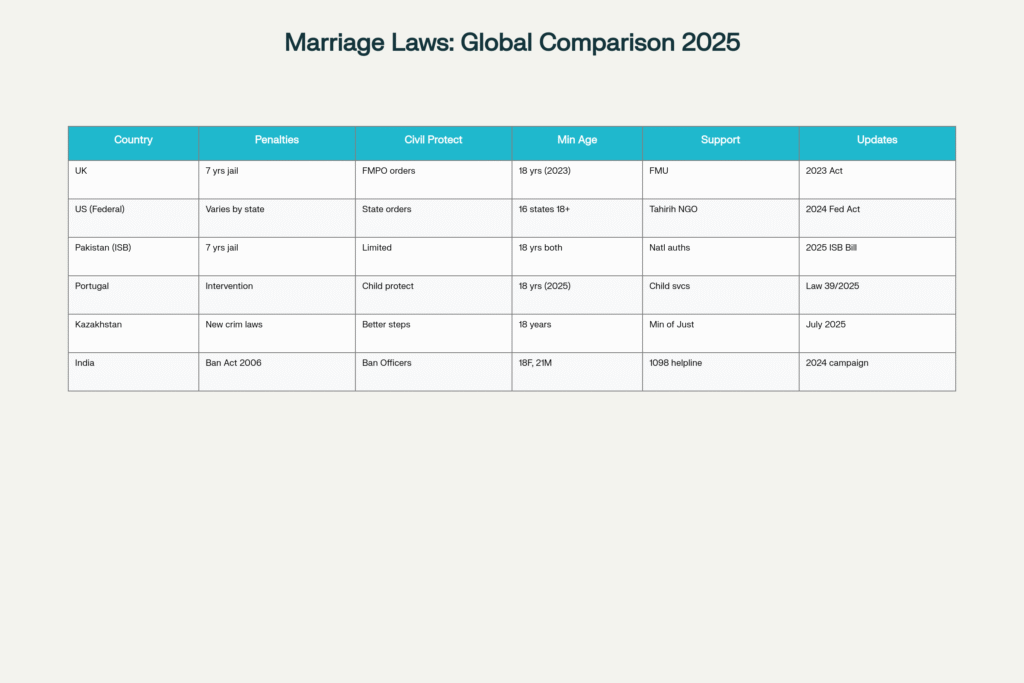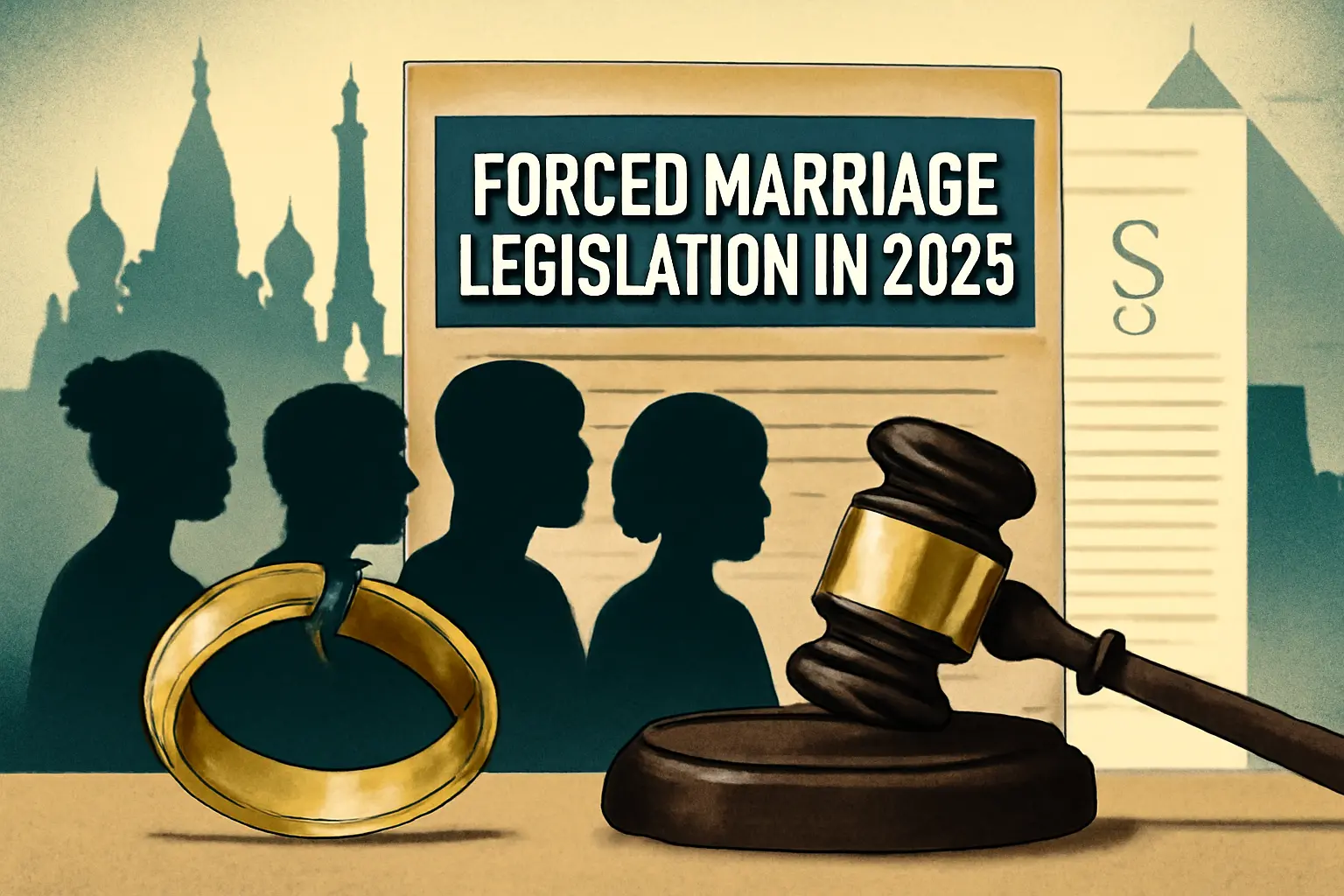The landscape of forced marriage legislation underwent significant transformation in 2025, marked by strengthened legal frameworks, enhanced criminal penalties, and expanded protection mechanisms across multiple jurisdictions. This comprehensive analysis examines the key developments, legal provisions, and institutional reforms that have emerged to combat forced marriage as a global human rights violation.
While there is no single piece of legislation titled “Forced Marriage Act 2025,” the year marked a watershed moment for legislative action against forced and child marriage worldwide. Multiple countries and jurisdictions enacted significant reforms, creating a patchwork of strengthened protections that collectively represent the most comprehensive response to forced marriage in recent history.

Recent Legislative Developments and Key Reforms
United Kingdom: Strengthening Existing Framework
The United Kingdom, which criminalized forced marriage in 2014 under the Anti-Social Behaviour, Crime and Policing Act, implemented additional reforms in 2025 building on the Marriage and Civil Partnership (Minimum Age) Act 2023. The UK framework remains one of the most comprehensive globally, featuring:[1][2]
- Criminal Penalties: Forcing someone to marry carries a maximum sentence of seven years imprisonment, while breaching a Forced Marriage Protection Order (FMPO) can result in up to five years imprisonment. The legislation encompasses taking someone overseas to force them to marry, regardless of whether the marriage takes place, and specifically criminalizes any act intended to cause a child to marry before their eighteenth birthday.[2]
- Civil Protections: The Forced Marriage Protection Order system allows victims or third parties to apply for court orders containing tailored restrictions and requirements, such as passport surrender and non-harassment provisions. These orders can be obtained without notice in emergency situations and may include powers of arrest.[3][4][5]
- Institutional Support: The Forced Marriage Unit (FMU), a joint Foreign, Commonwealth and Development Office and Home Office initiative, provides comprehensive support including a 24/7 helpline, training programs, and victim repatriation assistance. The unit handled 302 cases in 2022, with almost one-third affecting victims aged 17 or under.[1][2]
United States: Federal Framework Development
The United States made unprecedented progress in 2025 with the introduction of the Child Marriage Prevention Act of 2024 (S.4990), representing the first comprehensive federal response to child and forced marriage. Key provisions include:[6][7]
- National Commission: Establishment of a National Commission to Combat Child Marriage within the Department of Health and Human Services, tasked with conducting comprehensive studies and developing elimination strategies. The commission includes survivor representation and experts from relevant fields.[7]
- State Incentives: Up to 10% funding increases for states that ban child marriage under existing Violence Against Women Act programs, with $5 million authorized annually from 2027-2032.[7]
- Immigration Reforms: Significant amendments to marriage-based visa requirements, establishing 18 as the minimum age for both petitioners and beneficiaries, with limited humanitarian waivers for those aged 16-17. The reforms specifically exclude parental consent, pregnancy, or having children together as grounds for waivers.[7]
- Federal Property Restrictions: Prohibition of marriages involving anyone under 18 on federal property, including military bases.[7]
As of 2025, 16 US states have completely banned child marriage with 18 as the minimum age without exceptions, while 34 states continue to permit child marriage under certain circumstances. Four states (California, Mississippi, New Mexico, and Oklahoma) set no statutory minimum age when all exemptions are considered.[8][9]
International Developments (Forced Marriage Act)
- Pakistan: The Islamabad Capital Territory Child Marriages Restraint Bill 2025 raised the minimum marriage age to 18 for both men and women, with penalties up to seven years imprisonment for those facilitating child marriages. This builds on similar legislation in Sindh province from 2013.[10]
- Portugal: Law No. 39/2025 completely prohibited marriage of minors, establishing 18 as the absolute minimum age and eliminating all previous exceptions for 16-17 year olds with parental consent. The law also repealed emancipation provisions and included child marriage as grounds for child protection intervention.[11]
- Kazakhstan: New criminal legislation in July 2025 introduced specific liability for coercion into marriage and stalking, with penalties including fines, corrective labor, community service, or arrest up to 50 days.[12]

Legal Frameworks and Protection Mechanisms
Criminal Law Approaches
The criminalization of forced marriage has evolved from addressing component crimes (assault, kidnapping, rape) to creating specific offenses targeting the practice itself. Modern legislation typically includes:
- Primary Offenses: Direct criminalization of forcing someone into marriage through violence, threats, coercion, or abuse of vulnerability. Penalties range from 5-7 years imprisonment in most jurisdictions.[2][12]
- Secondary Offenses: Aiding, abetting, or facilitating forced marriages, including transporting victims across borders for marriage purposes. The UK was among the first to criminalize taking someone overseas for forced marriage regardless of whether the ceremony occurs.[2]
- Enhanced Penalties: Aggravated circumstances such as involving minors, repeat offenses, or organized elements typically result in increased sentences.
Civil Protection Systems
Civil remedies provide immediate protection without requiring criminal prosecution, addressing victim concerns about family members facing imprisonment:
- Protection Orders: Specialized Forced Marriage Protection Orders (UK model) or general domestic violence protection orders adapted for forced marriage contexts. These can include residence restrictions, passport seizure, communication bans, and mandatory counseling.[3][4]
- Emergency Provisions: Most systems allow for ex parte (without notice) applications in urgent situations, with powers of arrest attachable to orders.[5]
- Third-Party Applications: Recognition that victims may be unable to apply themselves, allowing local authorities, police, or other concerned parties to seek protection.[4]
Immigration Law Intersections
The intersection of immigration and marriage law creates particular vulnerabilities, leading to targeted reforms:
- Age Requirements: Establishing minimum ages for both petitioners and beneficiaries in marriage-based immigration cases, as implemented in the US Child Marriage Prevention Act.[7]
- Verification Procedures: Enhanced scrutiny of marriage documentation, particularly for cross-border cases involving age disparities.
- Support Services: Specialized assistance for immigrant victims who may face additional barriers including language, legal status concerns, and cultural isolation.
Implementation Challenges and Enforcement Issues
Detection and Reporting
Forced marriage often occurs within private family settings, making detection challenging. Effective systems require:
- Training Programs: Comprehensive education for frontline professionals including teachers, healthcare workers, social services, and law enforcement.[2]
- Community Engagement: Outreach to at-risk communities while respecting cultural sensitivities and avoiding stigmatization.
- Reporting Mechanisms: Confidential helplines and reporting systems that protect victim identity while enabling intervention.
Victim Support Services
Specialized support services address the unique needs of forced marriage victims:
- Emergency Accommodation: Safe housing options that consider the specific risks faced by those fleeing forced marriage, including potential family and community persecution.
- Legal Assistance: Specialized legal aid covering immigration issues, divorce proceedings, protection orders, and custody matters.
- Counseling and Mental Health: Trauma-informed care addressing the psychological impact of forced marriage and family rejection.
Cross-Border Challenges
International cases require coordination between jurisdictions:
- Consular Assistance: Embassy and consulate support for citizens trapped abroad, as provided by the UK’s Forced Marriage Unit.[2]
- Information Sharing: Coordination between countries to track cross-border movement for forced marriage purposes.
- Repatriation Support: Assistance returning victims to their home countries safely.
Statistical Landscape and Prevalence
United States
Between 2000 and 2018, over 300,000 minors were legally married in the United States, with most being 16-17 years old but some as young as 10. The majority of these marriages involved girls married to adult men, creating dangerous power imbalances. From 2007-2017, U.S. immigration authorities approved 8,686 marriage-based visa petitions involving at least one minor.[8][7]
United Kingdom
The UK’s Forced Marriage Unit provided support to 302 cases in 2022, with statistics showing the West Midlands has the country’s highest percentage of cases at 17% after London. The unit reported handling 337 cases in 2021, compared to 759 in 2020, though data comparability limitations make trend analysis difficult.[1]
Global Context
UNICEF data indicates India accounts for one-third of the world’s child brides, with approximately 23% of women aged 20-24 married before age 18. The COVID-19 pandemic and economic disruptions have exacerbated risks, with climate-induced displacement in countries like Pakistan leading to increases in so-called “monsoon brides”.[13][14]
Human Rights Framework and International Standards
International Legal Instruments
Forced marriage violates multiple international human rights instruments:
- Universal Declaration of Human Rights: Establishes the right to free and full consent in marriage.[15]
- Convention on the Rights of the Child: Requires state parties to set minimum marriage age at 18 and ensure full consent.[16]
- Convention on the Elimination of All Forms of Discrimination Against Women (CEDAW): Prohibits child and forced marriage as discrimination against women.[16]
- Istanbul Convention: Creates binding obligations for European states to criminalize forced marriage.[17]
Regional Approaches
- Council of Europe: Resolution 1468 (2005) urged member states to set minimum marriage age at 18 and consider criminalizing forced marriage. The Istanbul Convention now provides binding legal framework.[18]
- African Union: New convention on ending violence against women and girls includes provisions on child marriage.[14]
- SADC: Model law on child marriage provides framework for Southern African states.[14]
Economic and Social Impact Analysis
Educational Consequences
Child marriage significantly impacts educational attainment, with women marrying before age 19 being 50% more likely to drop out of high school and four times less likely to graduate college. This educational deficit perpetuates cycles of poverty and limits economic opportunities.[7]
Health Implications
Early marriage correlates with numerous health risks, including 23% greater risk of developing serious conditions like diabetes, cancer, heart attack, or stroke for women married before 19. Mental health impacts include higher rates of psychiatric disorders among women who married as children.[7]
Economic Costs
Girls marrying in early teens face up to 31% higher likelihood of future poverty. The divorce rate for marriages involving at least one person under 18 ranges from 70-80%, often leaving young women economically vulnerable.[7]
Technology and Modern Challenges
Digital Threats
Modern forced marriage cases increasingly involve digital surveillance, online harassment, and technology-enabled coercion. Legal frameworks must address:
- Cyberstalking: As seen in Kazakhstan’s 2025 reforms, which specifically criminalized stalking alongside forced marriage.[12]
- Digital Evidence: Courts must adapt to handle social media evidence, messaging apps, and location tracking in forced marriage cases.
- Online Recruitment: Internet-based marriage brokering and international matching services may facilitate forced marriages.
Future Directions and Reform Priorities
Legislative Harmonization
The patchwork of different legal approaches creates enforcement challenges and protection gaps. Priority areas include:
- Minimum Age Standardization: Movement toward universal 18-year minimum marriage age without exceptions.
- Cross-Border Cooperation: Enhanced international legal cooperation mechanisms for cases spanning multiple jurisdictions.
- Immigration Reform: Coordinated approach to marriage-based immigration fraud and exploitation.
Institutional Development
- Specialized Units: Expansion of the UK Forced Marriage Unit model to other jurisdictions, providing centralized expertise and victim support.
- Training Programs: Mandatory training for judges, law enforcement, social workers, and other frontline professionals.
- Data Collection: Improved statistics gathering to understand prevalence and track progress.
Prevention Strategies
- Community Engagement: Culturally sensitive outreach programs that work with communities to change attitudes while respecting diversity.
- Education Initiatives: School-based programs teaching consent, legal rights, and available support services.
- Economic Empowerment: Programs addressing poverty and lack of opportunities that contribute to child marriage decisions.
Conclusion: Forced Marriage Act
The year 2025 marked a significant advancement in global efforts to combat forced marriage, though the absence of a single “Forced Marriage Act 2025” reflects the complex, multi-jurisdictional nature of this human rights challenge. The convergence of criminal law reforms, civil protection enhancements, immigration policy changes, and institutional development represents the most comprehensive legislative response to forced marriage in history.
The UK’s mature framework demonstrates the effectiveness of combining criminal sanctions with civil protections and specialized support services. The United States’ proposed federal legislation represents a paradigm shift from purely state-level responses to comprehensive national strategy. Meanwhile, developments in Pakistan, Portugal, Kazakhstan, and other jurisdictions show the global momentum toward stronger protections.
However, significant challenges remain. Implementation gaps, enforcement difficulties, and the hidden nature of many forced marriages continue to limit the effectiveness of legal reforms. The varying approaches across jurisdictions create opportunities for forum shopping and cross-border exploitation. Most critically, the intersection of cultural practices, economic pressures, and legal protections requires nuanced approaches that protect rights while respecting diversity.
Moving forward, success will depend on sustained political commitment, adequate resource allocation, international cooperation, and most importantly, meaningful engagement with affected communities and survivors. The legislative foundations established in 2025 provide a strong framework, but their ultimate effectiveness will be measured by their ability to prevent forced marriages, protect victims, and hold perpetrators accountable across all communities and contexts.
The evolution of forced marriage legislation in 2025 demonstrates that when political will combines with advocacy pressure and evidence-based policy making, significant legal reforms are possible. The challenge now lies in ensuring these new laws translate into genuine protection and justice for those at risk of or affected by forced marriage worldwide.
- https://www.bbc.com/news/uk-england-birmingham-64873897
- https://www.gov.uk/guidance/forced-marriage
- https://www.lexisnexis.co.uk/legal/family-law/emergency-procedures/forced-marriage-protection-orders
- https://www.biscoes-law.co.uk/site/private-solicitors/child-law/forced-marriage-protection-order/
- https://anthonygold.co.uk/insight/forced-marriage-protection-order-fmpo/
- https://www.tahirih.org/news/child-marriage-prevention-act-of-2024/
- https://www.congress.gov/bill/118th-congress/senate-bill/4990/text
- https://en.wikipedia.org/wiki/Child_marriage_in_the_United_States
- https://www.tahirih.org/wp-content/uploads/2025/04/Child-Marriage-in-the-States-Two-Pager.pdf
- https://www.idea.int/democracytracker/report/pakistan/may-2025
- https://www.raassociados.pt/en/artigos/publicacao-lei-n-o-39-2025-casamento-apenas-permitido-a-quem-atinja-os-18-anos
- https://astanatimes.com/2025/07/kazakhstan-criminalizes-stalking-and-forced-marriage-in-new-law/
- https://cdnbbsr.s3waas.gov.in/s3ec046e16656a6ee1de7232164767ccfa/uploads/2025/04/2025042859.pdf
- https://www.girlsnotbrides.org/articles/global-dialogue-urges-progress-towards-ending-child-marriage/
- https://en.wikipedia.org/wiki/Forced_marriage
- https://www.ohchr.org/en/women/child-and-forced-marriage-including-humanitarian-settings
- https://www.lastradainternational.org/news/forced-marriage-campaign/
- http://www.stopvaw.org/international_and_domestic_law_and_policy_on_forced_and_early_marriage
